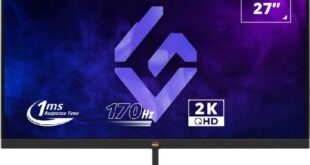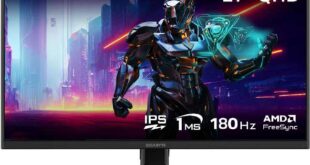A leading brand in laptops and monitors, Gigabyte’s products are a common sight in the gaming segment due to various factors such as affordability, reliability, and a well-established sales and service network. Gigabyte M27Q X review, here is a gaming and entertainment-focused option that claims to be suitable for both productivity and leisure use.
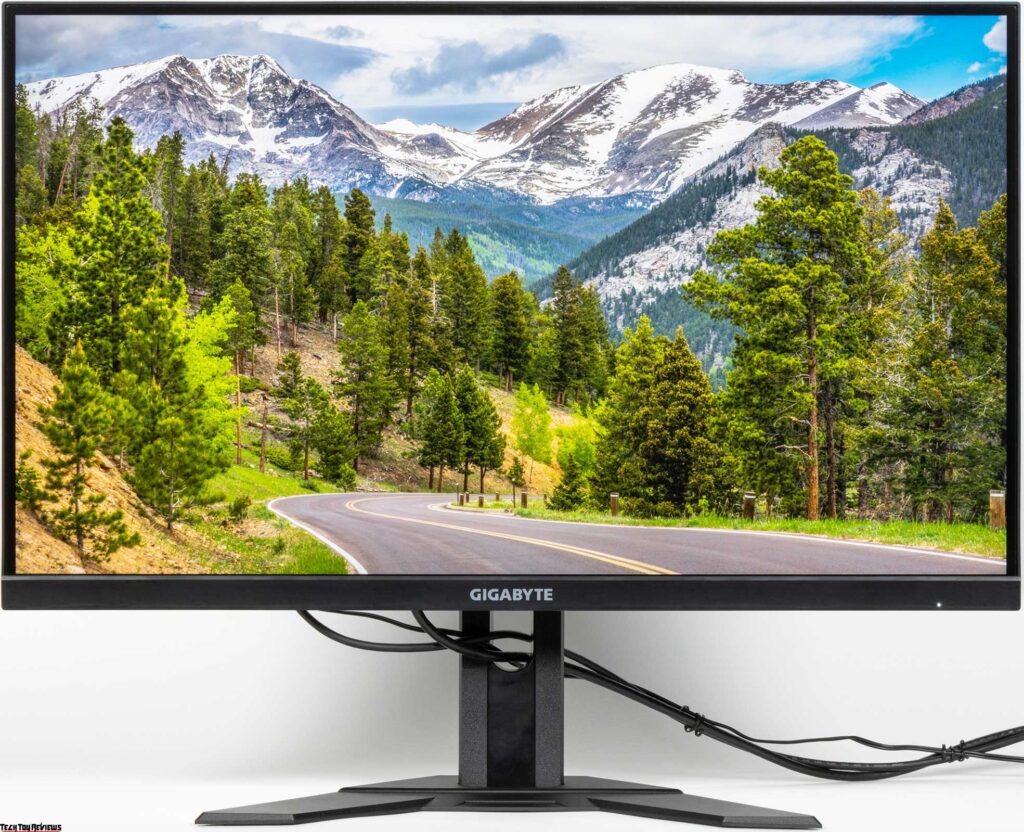
Design
In general, the design is moderately playful, so in terms of appearance, the Gigabyte monitor can be considered universal. The monitor panels and stand covers are made of black plastic, mostly with a matte surface, but in some places, there is a small embossed pattern and glossy areas.
The outer surface of the panel is black, semi-matte, and hard. The screen looks like a monolithic surface, bounded at the bottom by a relatively narrow bar and at the top and sides by a narrow border. Having displayed the image on the screen, you can see that there are narrow margins between the outer borders of the screen and the actual display area – 8 mm to the outer edges of the top and sides and about 1 mm to the bar from the bottom.
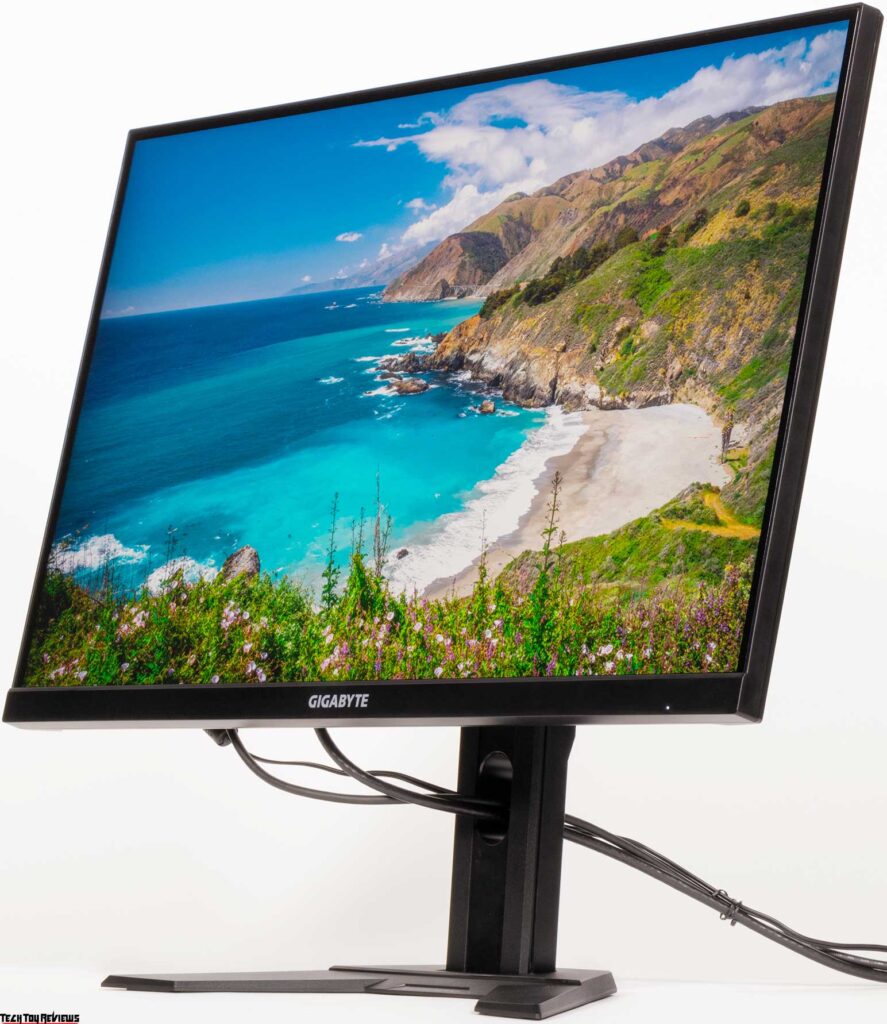
In the center of the front bar is the manufacturer’s logo, unpretentiously made in light gray paint.
On the rear panel, close to the edge under the right hand, there is a KVM switch and a convenient 5-way joystick (four-way deflection and pressing). On the front bar downstairs and closer to the right edge is a diffuser for the status indicator.
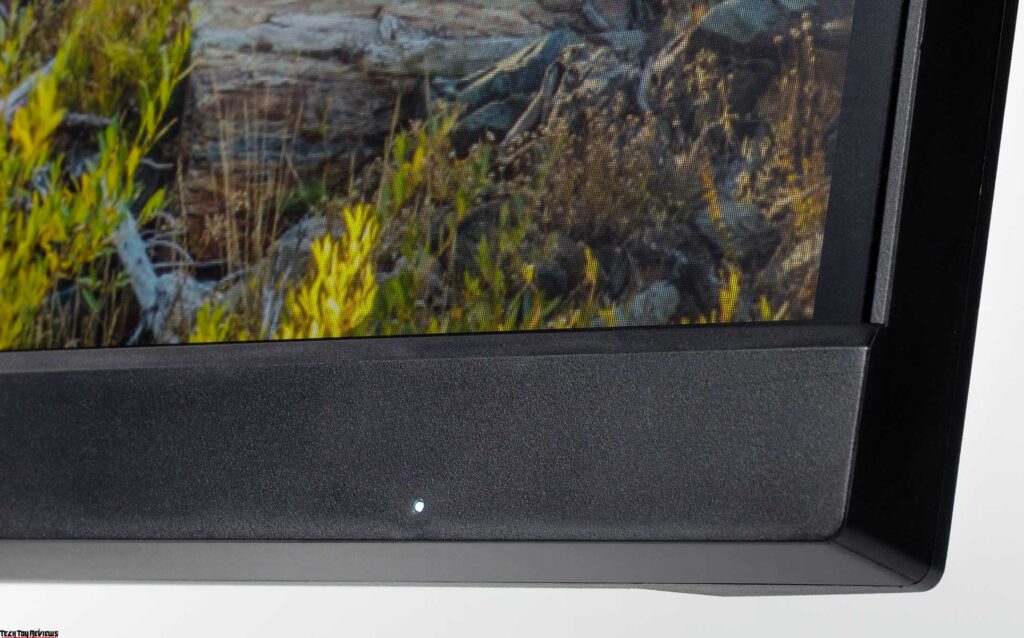
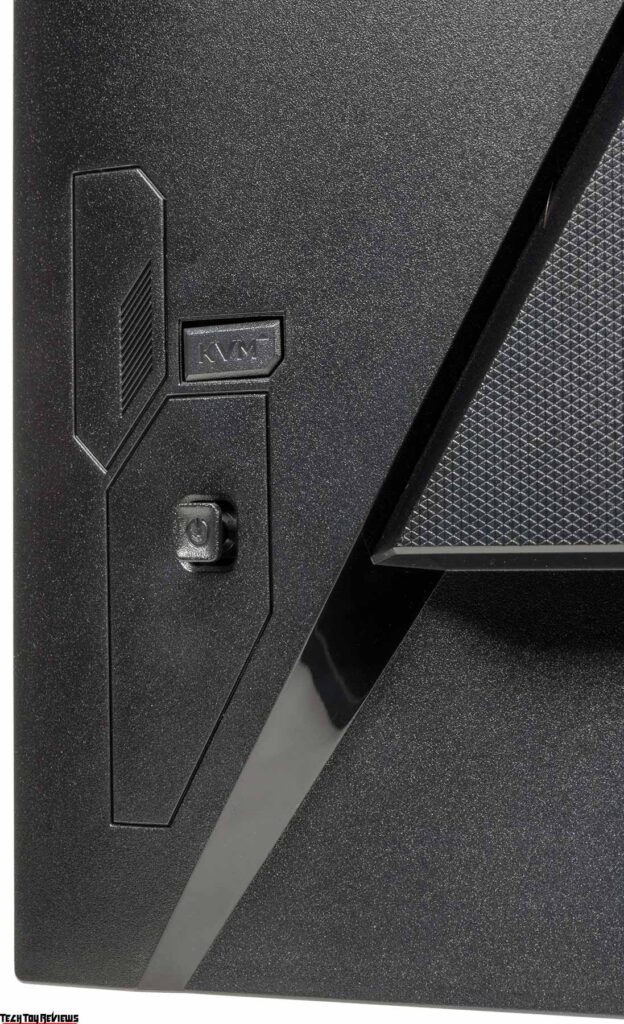
The power connector, interface connectors, and a Kensington lock connector are located in an open niche at the back and are oriented downwards.
The steel plate on which the connectors are located has a black matte finish. Connecting cables are inconvenient. Outgoing cables can be routed through a cutout at the bottom of the stand.
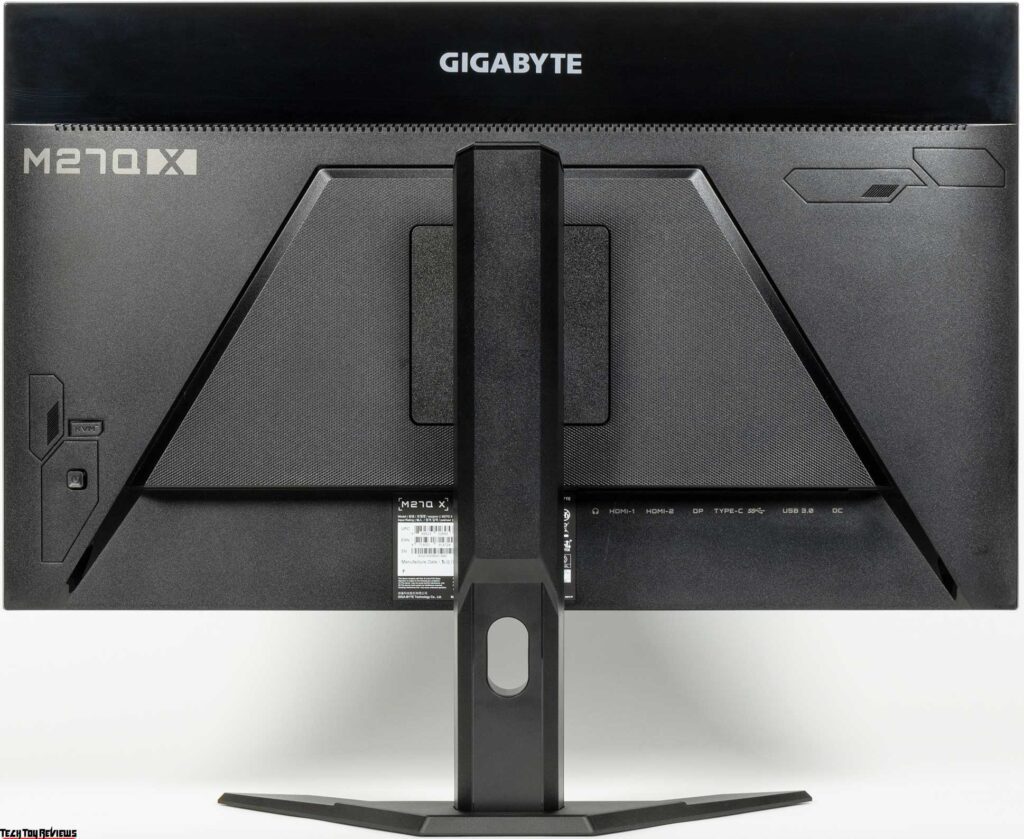
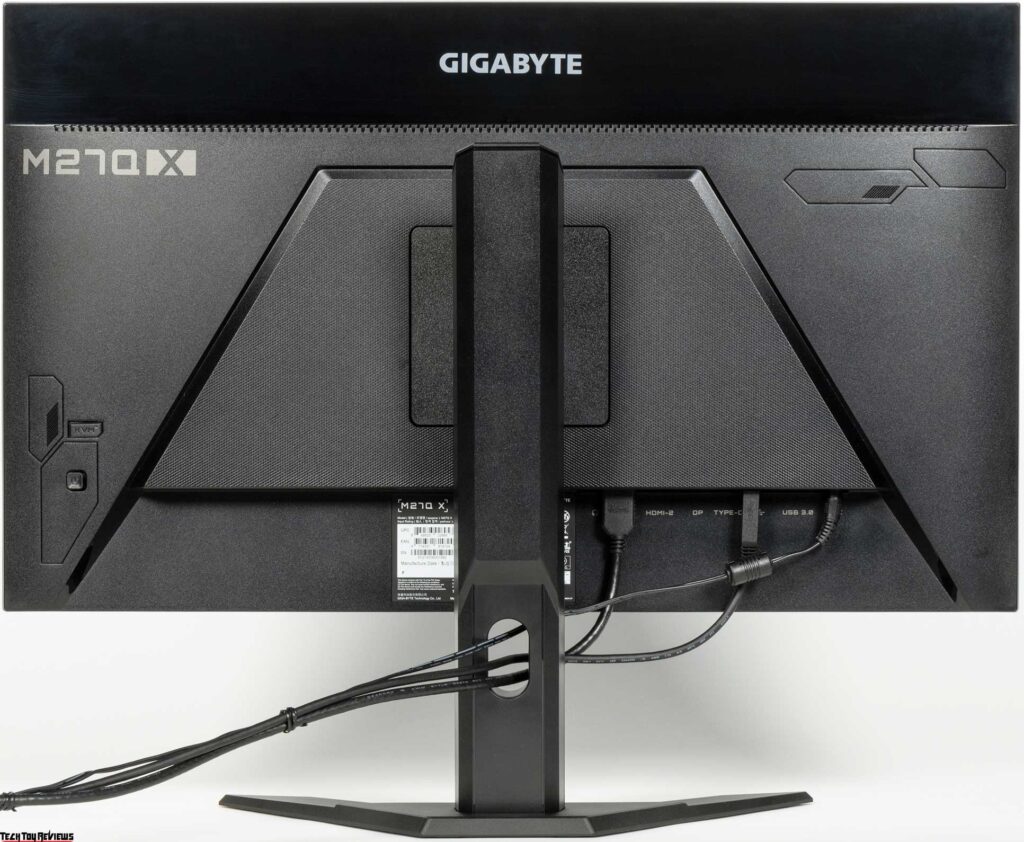
There is a mesh at the back at the top through which the hot air escapes. There are two speakers behind it. From below, air passes through holes in the bar with connectors.
The supporting elements of the stand are made of thick stamped steel and aluminum alloy. The legs of the stand base deviate widely to the sides, which provides good stability to the monitor, while the edge of the stand can be placed above the horizontal surface of the base. Rubber pads on the bottom of the support planes of the stand base protect the table surface from scratches and prevent the monitor from sliding on smooth surfaces.
The stand has a fixed height, but a spring-supported mechanism with a steel rail ball bearing ensures vertical movement of the hinge onto which the screen assembly is mounted. As a result, with a slight movement of the hand, the screen can be set to the desired height. The top hinge allows the screen unit to tilt slightly forward from a vertical position and tilt back more.

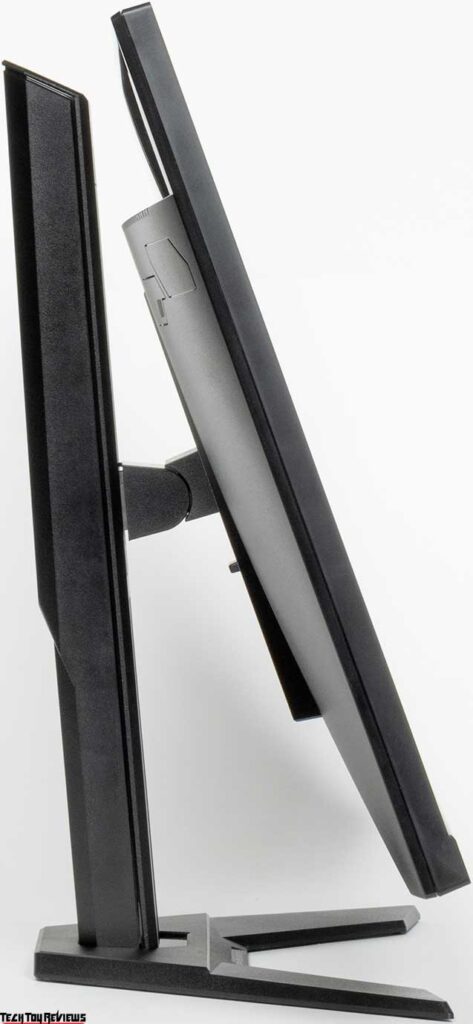

The stand on the screen block is fastened with latches in one movement, and it is also detached simply by holding the latch slider. If necessary, the stand can be detached, and the screen unit can be mounted on a VESA-compatible bracket (100 x 100 mm).
Connectivity
The Gigabyte M27Q X monitor has three full-sized digital inputs – DisplayPort and a pair of HDMI – complemented by a USB-C input. Input selection is made in the main setup menu or the quick access menu (if configured). There is a switchable function of automatic signal search at the inputs.
There is a built-in USB hub (3.0) for two ports. USB outputs support fast charge mode (BC 1.2). The KVM switch, which is not often found in monitors, is also available – you can connect a keyboard and mouse (or a drive) to the monitor via USB, so that they can be used with two video sources, for example, with a PC and a laptop, or with a PC and a tablet. In this case, one of the sources must be connected via USB-C (video signal input via the same interface, via DisplayPort, or HDMI), and the second via USB via the USB-B connector (video signal input via either DisplayPort or HDMI).
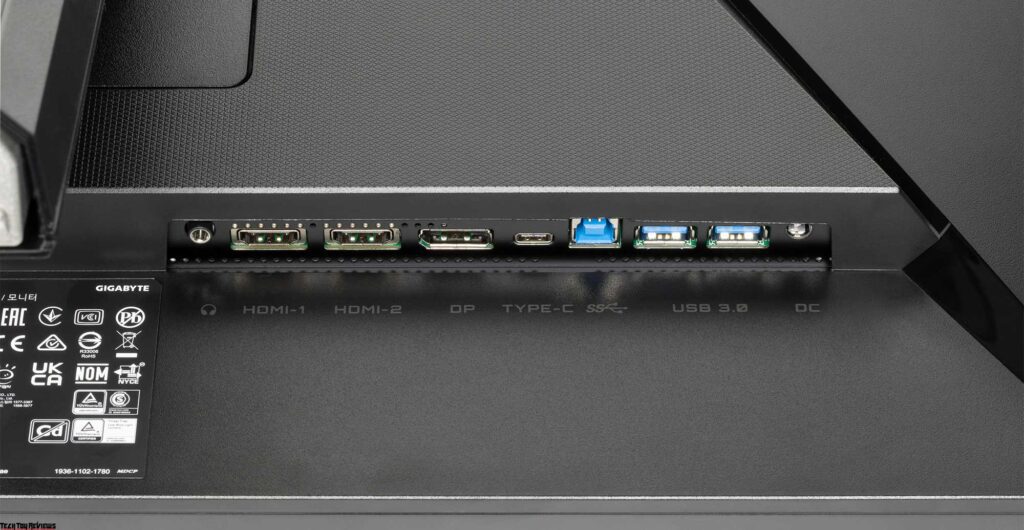
On the rear panel, there is a separate mechanical button for switching between sources, it can also be replaced by an item in the monitor’s quick menu and a button in the OSD Sidekick application. Another way the KVM switch works is simple to input selection.
The USB Type C port delivers power to the device connected to it with a declared power of up to 18 watts. Connecting our dead-battery laptop and running load tests on it increased the monitor’s consumption by 15 watts from the outlet. In this case, it is enough to charge an inactive laptop or reduce the discharge rate of the laptop under load.
Audio
Digital audio signals from the DisplayPort, HDMI, and USB-C inputs are converted to analog and output to the built-in speakers and 3.5mm jack. You can connect an externally powered speaker system or headphones to this jack. The power of the headphone output was enough to have a large headroom in 32-ohm headphones with a sensitivity of 92 dB. The sound quality in the headphones is good – the sound is quite clear, a wide range of frequencies is reproduced, and noise is not heard during pauses.
The built-in loudspeakers sound according to their size and the acoustic environment – so loud that the user sitting in front of the monitor can confidently hear system signals, without low frequencies at all, with a pronounced “plastic” overtone due to cabinet resonances, the stereo effect is present.
Menu, bundled software, and additional functions
The power indicator glows moderately bright white during operation, slowly blinks white in standby mode, and does not light if the monitor is turned off. In the menu, the operation of the indicator can be turned off or left only in standby mode. The monitor is turned on by pressing the joystick.
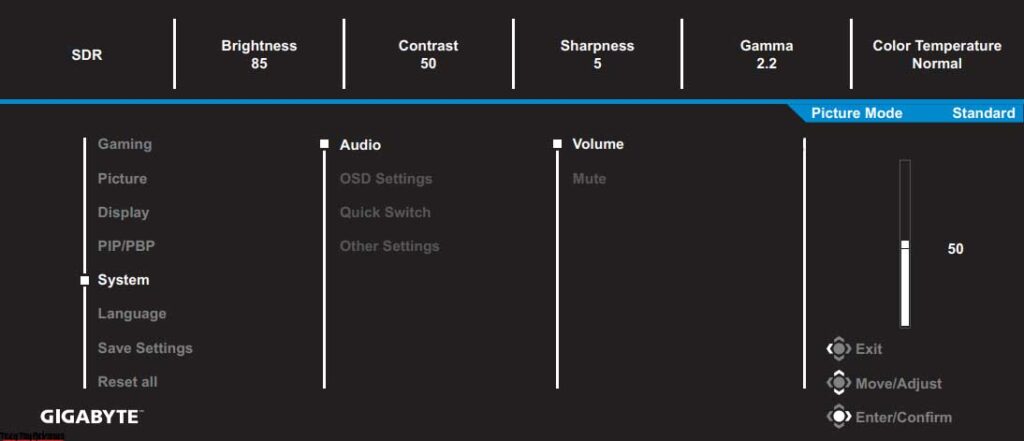
When our Gigabyte M27Q X review unit is on, and there is no menu on the screen, when the joystick is moved up, down, right, or left, a slider or a list of settings that are assigned to this joystick by the user.
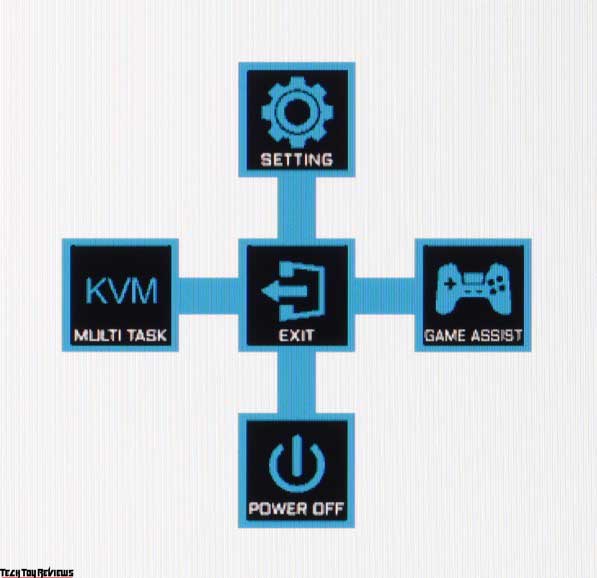
If it is on the screen, then pressing the joystick – exit the menu, tilting down – turn off the monitor (it can be turned off even without a menu by long-pressing the joystick), up – enter the main settings menu, right – menu with game functions settings, left – KVM menu.
Menu navigation is very convenient since everything is done only with a joystick, you do not need to transfer your finger to the buttons, and the number of necessary actions is reduced, besides, the lists are looped. When adjusting the image, the menu remains on the screen – this somewhat interferes with the assessment of the changes made. If necessary, you can set the level of transparency of the menu background, select a timeout for automatically exiting the menu, and enable the menu lock, which prevents accidental changes to settings.
An additional feature in the GameAssist, there are several gaming functions: a timer, a custom counter, refresh rate output, crosshair, and display alignment. There is also an Eagle Eye function – displaying a rectangular area on the screen with a magnification of 1.5, 2, 3, or 4 times for better aiming, while the user can choose the size of the area (3 options), its location on the screen and output with a red or white border or without a border. True, the maximum refresh rate with the magnifier turned on drops to 165 Hz.
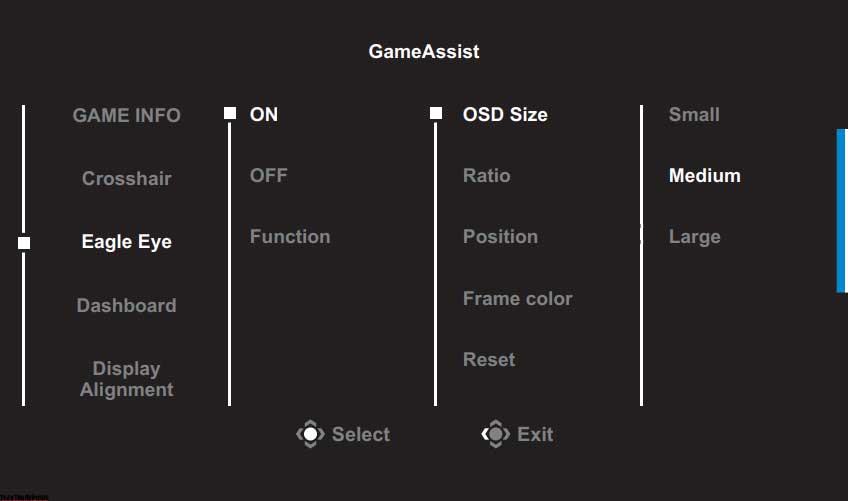
The Gigabyte M27Q X 1440p gaming monitor can be controlled by a PC using proprietary OSD Sidekick software. In addition to the settings available from the monitor menu, the OSD Sidekick allows you to save/load profiles, edit the crosshair shape, set keyboard shortcuts, configure and KVM switch, and update the monitor firmware. Only when the OSD Sidekick is running is the monitor displaying data on the Dashboard. And it is in OSD Sidekick that keyboard shortcuts are set, with which the user can increase and decrease the value of the user counter.
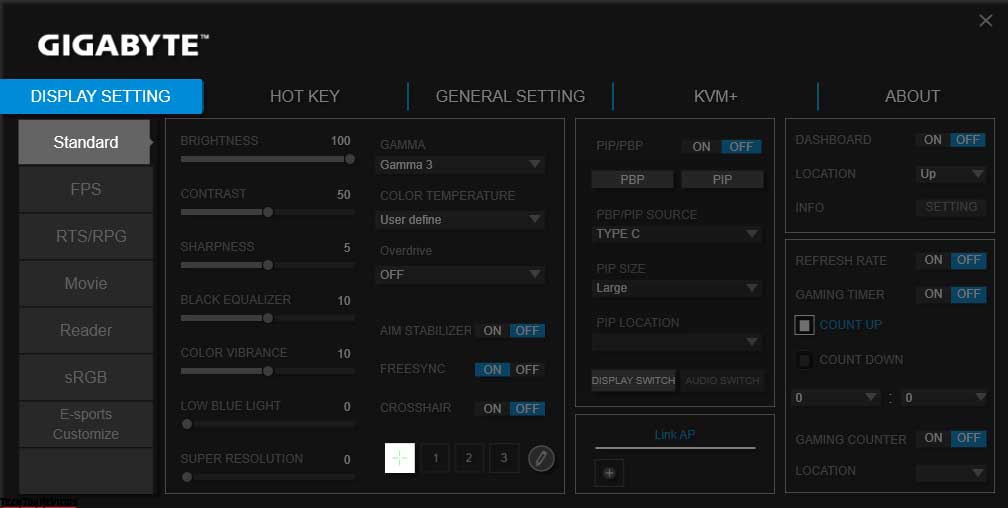
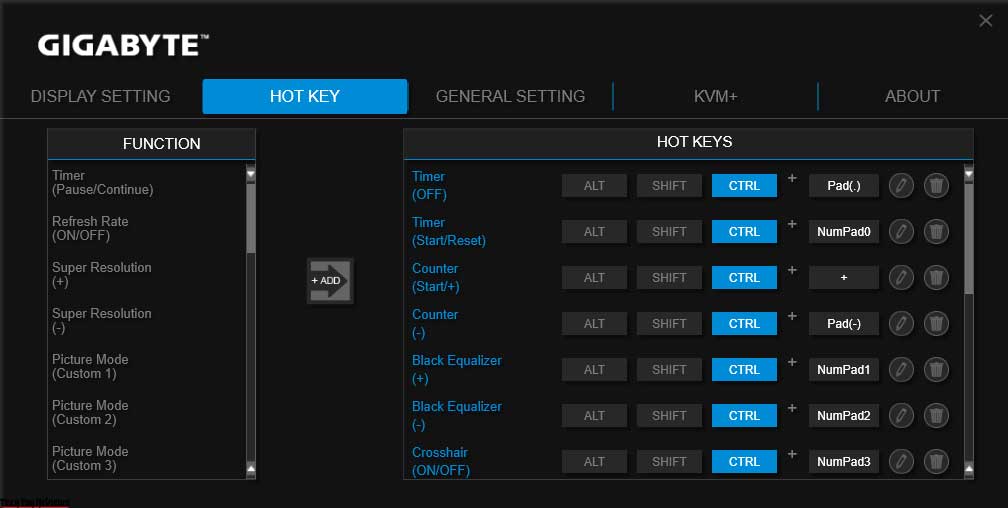
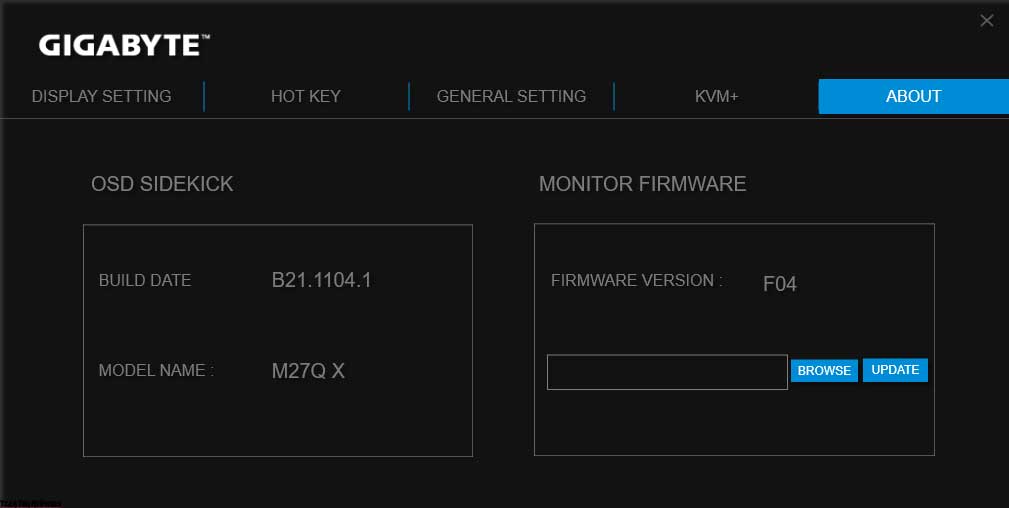
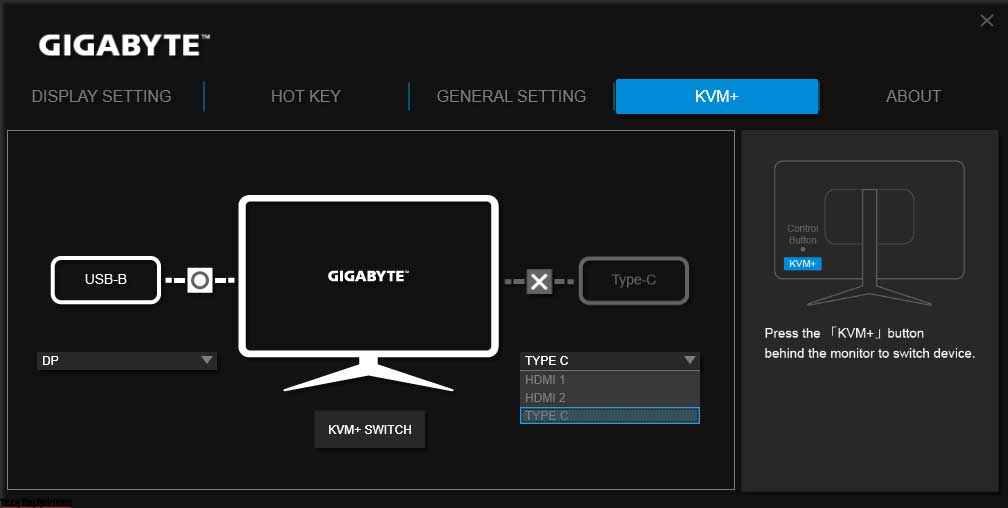
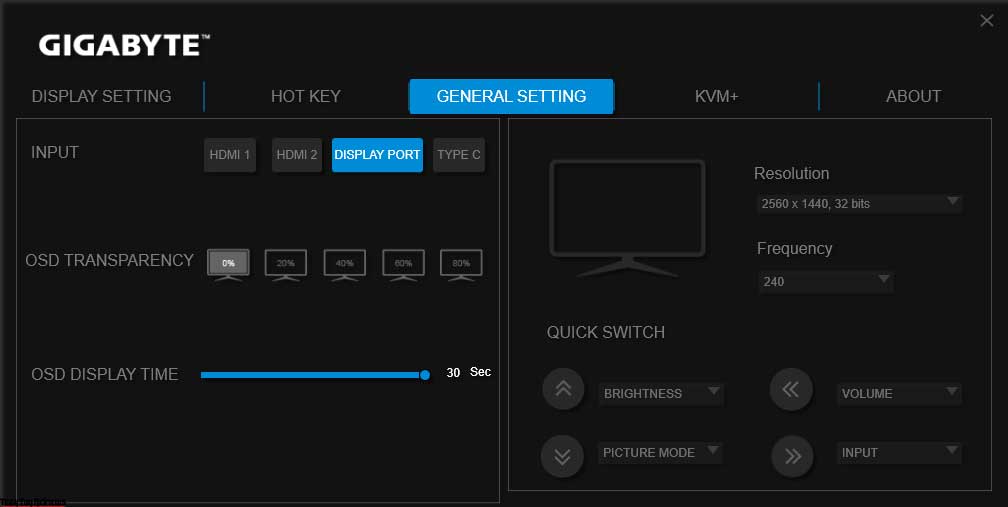
Gigabyte M27Q X specifications
- Display: 27-inch Non-glare SS IPS panel
- Display Viewing Area (HxV): 596.736 (H) x 335.664 (V) mm
- Color Saturation: 92% DCI-P3 / 140% sRGB
- Resolution: 2560 x 1440 (QHD)
- Pixel Pitch: 0.2331(H) x 0.2331(V) mm
- Brightness: 350 cd/m2(TYP)
- Contrast Ratio: 1000:1
- Viewing Angle: 178°(H)/178°(V)
- Display Colors: 10 bits(8 bits + FRC)
- Response Time: 1ms GTG
- Refresh Rate: 240Hz
- Features: VESA Display HDR400, Flicker-free, HBR3, OSD Sidekick, Aim Stabilizer Sync, Black Equalizer, Dashboard, Crosshair, Timer, Counter, PiP/PbP, Auto-Update, KVM, 6 axis Color Control, Smart OD, Kensington lock
- Connectivity: 2 x HDMI 2.0, 1 x Displayport 1.4, 1 x USB Type-C (Alternate Mode; Upstream port; Power Delivery up to 18W), 2 x USB 3.0 Downstream ports, 1 x USB 3.0 Upstream port, 1 x Earphone Jack
- Audio: 2W x 2 Speaker
- Stand: Tilt (-5°~+20°), Height Adjustment (130 mm)
- VESA Mounting: 100*100 mm
- Dimensions: 615.11 x 535.66 x 193.68 mm (with stand)
- Weight: 5.2 kg
Gigabyte M27Q X Review
Display
There are not very many settings that change the brightness and color balance. There is a set of preset settings in the form of several factory profiles, and three profiles are reserved for a custom combination of settings.
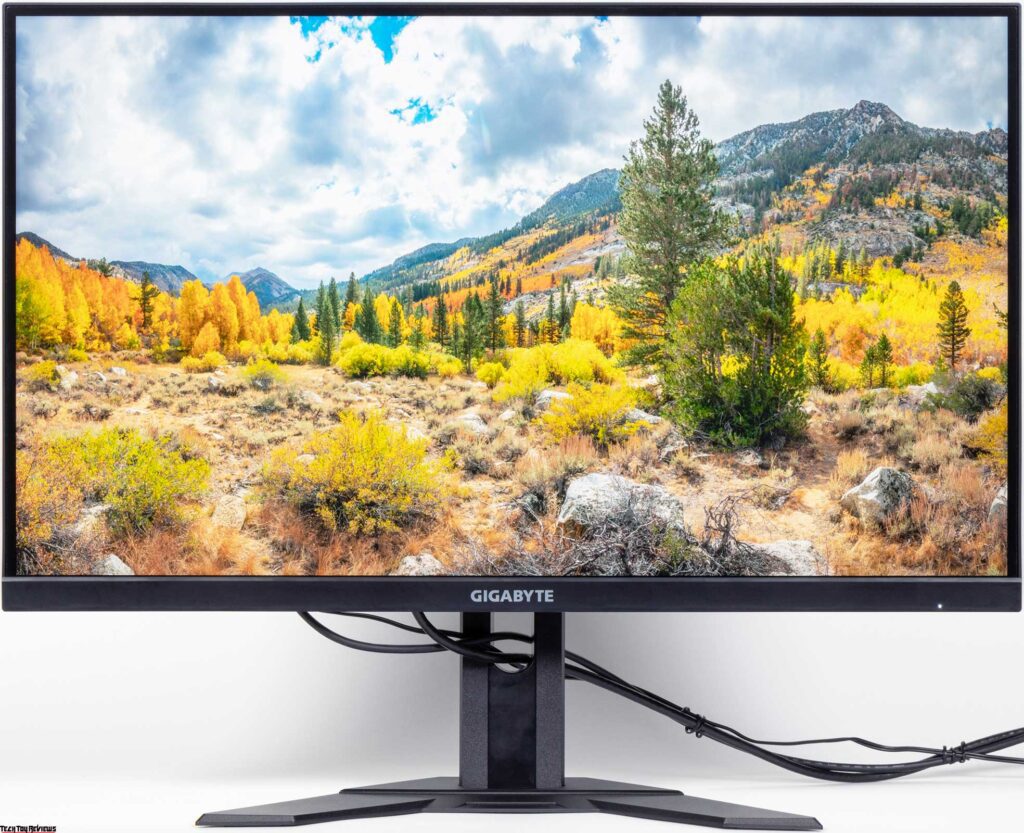
According to the developers, the settings which will be needed more often by users, have been moved to the Gaming page.

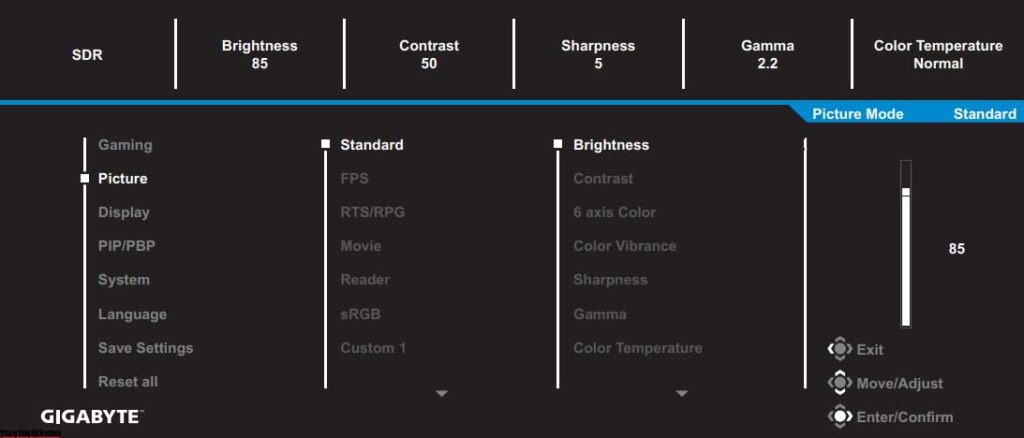
There are picture-in-picture (PIP) and picture-by-picture (PBP) functions. In PIP mode, the position of the additional window in one of the four corners is selected, as well as its size out of three possible (the largest is exactly the fourth part of the screen). The image in the additional window is displayed with the original proportions preserved. We got pixel-for-pixel output for the additional window when it was displayed on a quarter of the screen at a resolution of 1280 by 720 pixels. In PBP mode, you can get two 1280×1440 dot-to-dot images from independent sources filling the entire display area.
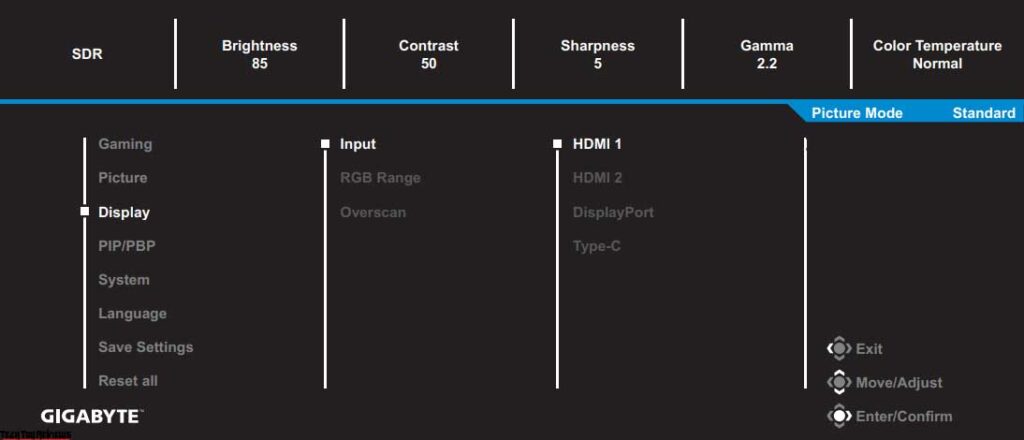
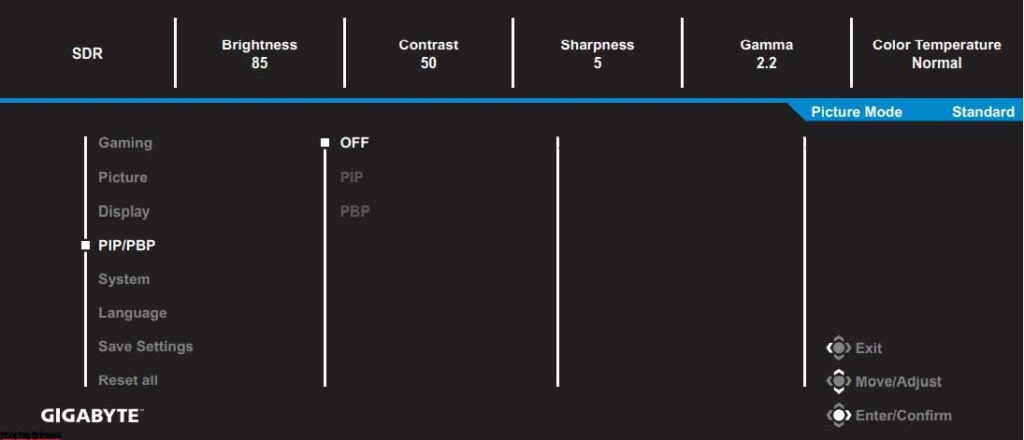
In the case of DisplayPort and a professional graphics card, 10 bits per color is supported, but the Gigabyte M27Q X output is in 8 bits per color. We conducted the test using the Nvidia Quadro K600 graphics card and the NEC Display Solutions 10-bit Color Depth Demo program. This test shows whether programs such as Adobe Photoshop and Adobe Premiere Pro that use OpenGL can achieve 10-bit color output on a professional graphics card such as Nvidia Quadro, AMD FirePro, or AMD Radeon Pro.
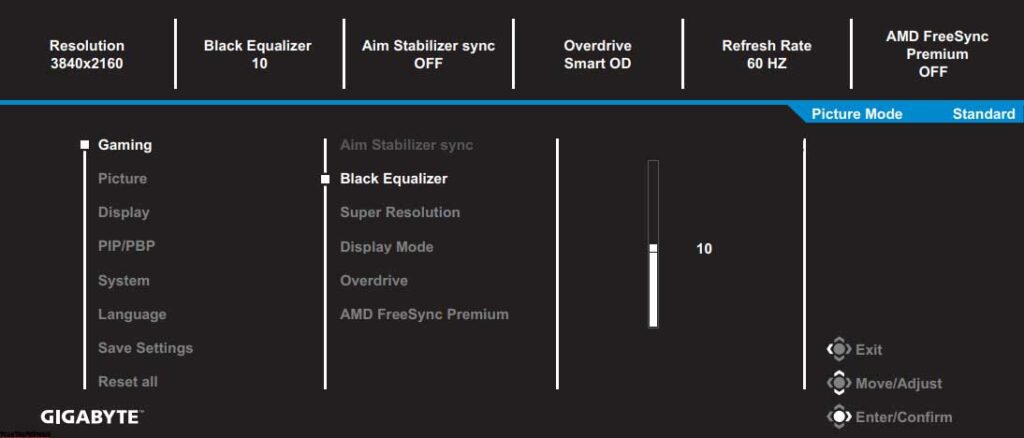
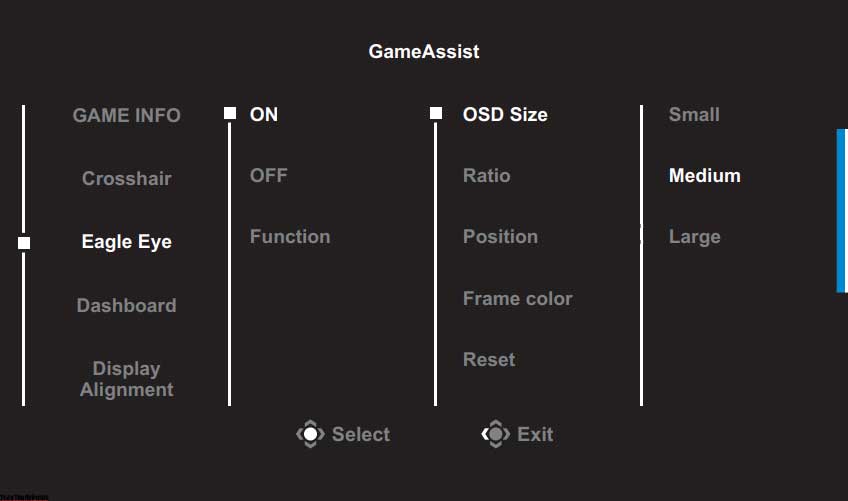
This Gigabyte gaming monitor supports FreeSync technology (precisely AMD FreeSync Premium) via DisplayPort and HDMI inputs. The supported frequency range, which is indicated on the graphics card settings panel, is 48-144 Hz for HDMI and 48-240 Hz for DisplayPort. The inclusion of FreeSync allowed us to get an image with smooth movement in the frame and without gaps. With Nvidia graphics cards, this Gigabyte M27Q X supports G-Sync in G-Sync Compatible mode, but only on the DisplayPort input. In the G-Sync Pendulum Demo utility, G-Sync mode is turned on, and there is smoothness without breaks, but the output stability is low. It was not possible to check the USB-C input for compatibility with FreeSync and G-Sync Compatible.
When connected to a computer via DisplayPort, a resolution of up to 2560 × 1440 at 240 Hz of the input frame rate was supported, and the image was also displayed on the screen at this frequency from 8 bits per color and 10 bits when the frequency was reduced to 200 Hz. In the case of HDMI – up to 2560 × 1440 at 144 Hz and 8 bits, and 60 Hz already 12 bits. These combinations of resolutions and refresh rates support HDR.
The image of the pixel structure is slightly blurry due to the matte surface, but the structure characteristic of IPS can be recognized (black dots are dust on the camera lens):
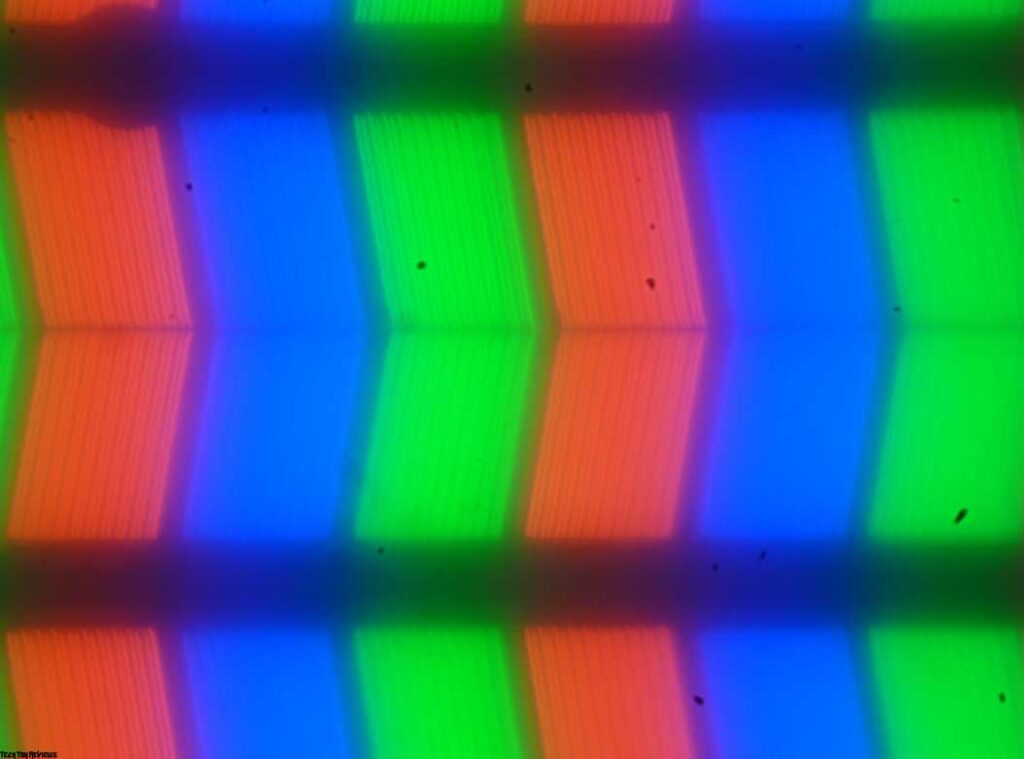
Focusing on the screen surface revealed randomly located surface micro defects, which are responsible for the matte properties:

The grain of these defects is several times smaller than the size of the subpixels (the scale of these two photographs is the same), therefore, focusing on micro defects and the jumping of focus on subpixels with a change in the angle of view are weakly expressed, because of this there is no crystal effect.
The actual gamma curve depends on the selected value in the Gamma list. The values of the indicators of the approximating function are given in brackets in the captions, in the same place – the coefficient of determination R2:
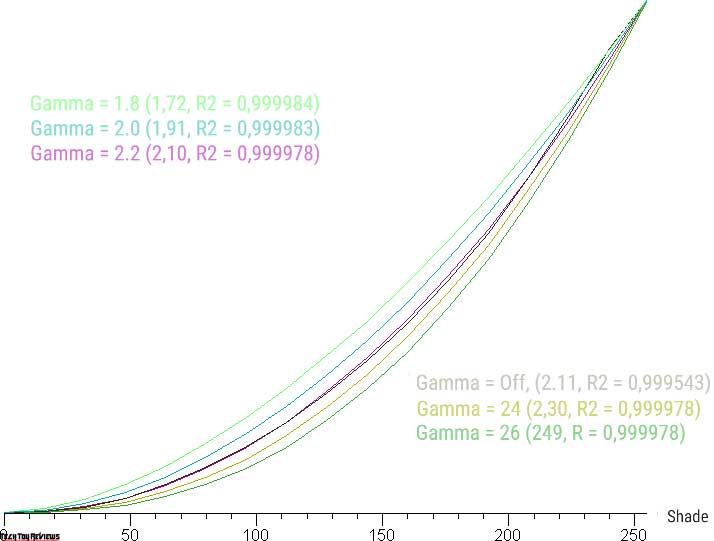
The actual gamma curve is closest to the standard one (taking into account the proximity of R2 to unity) when choosing the Gamma 2.2 option, so next, we measured the brightness of 256 shades of gray (from 0, 0, 0 to 255, 255, 255) at this value. The graph below shows the increase (not an absolute value!) in brightness between adjacent halftones:
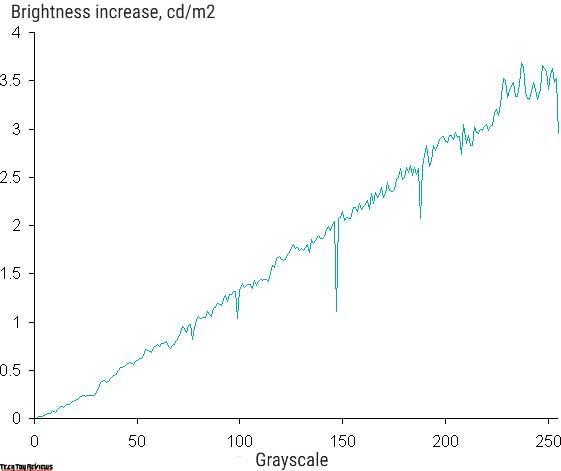
The increase in brightness is very uniform. Moreover, each next shade is significantly brighter than the previous one, except the first shade of gray closest to black, which does not differ from black in brightness:
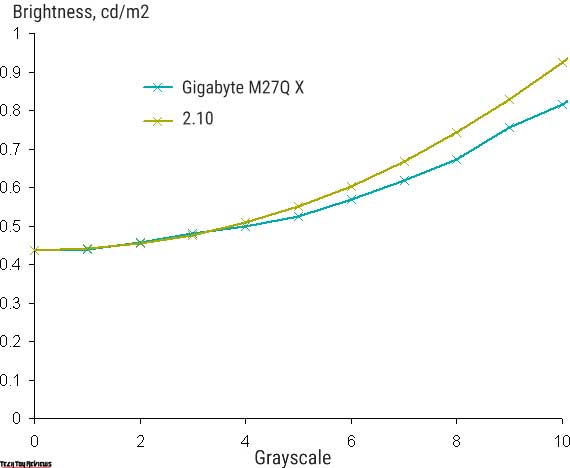
Approximation of the resulting gamma curve gave an indicator of 2.10, which is slightly less than the standard value of 2.2, while the real gamma curve deviates little from the approximating power function:
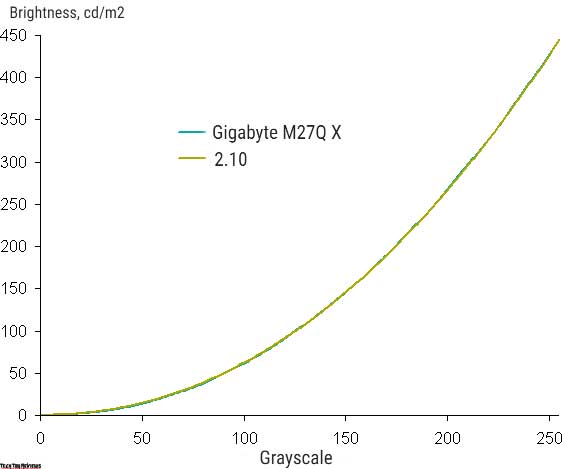
Additionally, by adjusting the Black Equalizer (from 0 to 20, default 10) you can adjust the gamma curve, improving the visibility of details in the shadows. It can be useful in games with dark scenes. Below are the gamma curves at several Black Equalizer values (built on 32 points):
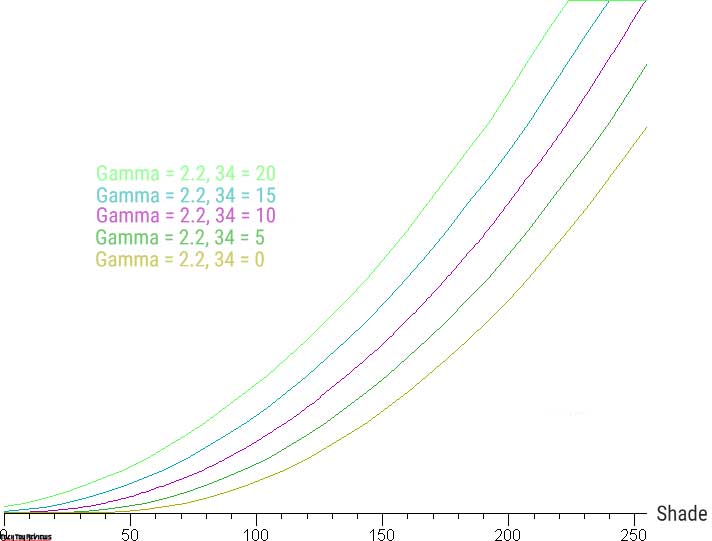
The original color gamut is noticeably wider than sRGB and approaches the gamut of Adobe RGB:
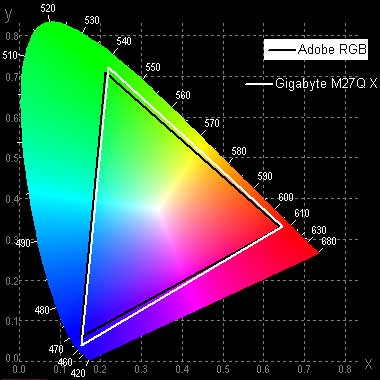
This coverage is obtained by selecting a profile other than sRGB. When choosing an sRGB profile, coverage is appropriate:
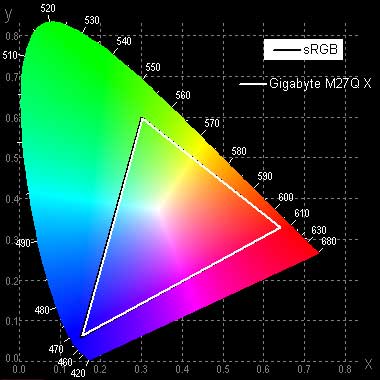
Below is the spectrum for a white field superimposed on the spectra of red, green, and blue fields (lines of the corresponding colors) in the case of the original color gamut:
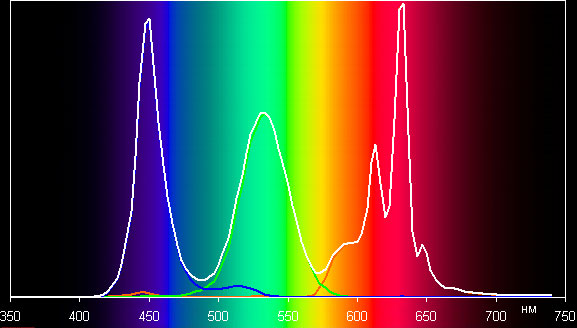
It can be assumed that backlight LEDs use a blue emitter and green and red phosphors, while the red phosphor (and maybe green) uses the so-called quantum dots. Good separation of the components allows you to get a wide color gamut. In the case of an sRGB profile with gamut adjustment, the components are mixed to a large extent:
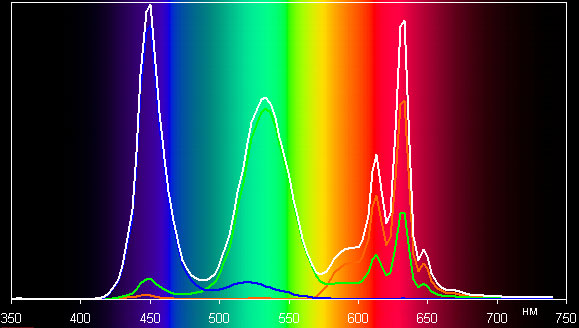
Color balance is simple when choosing a User Define profile to set Color Temp. (Color temperature), which provides maximum brightness and contrast while maintaining acceptable image quality, is excellent, and meets the criteria of professional monitors, since the color temperature is close to the standard 6500 K, and the deviation from the blackbody spectrum (parameter ΔE) is below 3. After selecting the sRGB profile is slightly balanced, but still good enough for any job that doesn’t require particularly accurate color reproduction. The graphs below show the color temperature in different areas of the grayscale and ΔE for User Define profiles without correction and sRGB.
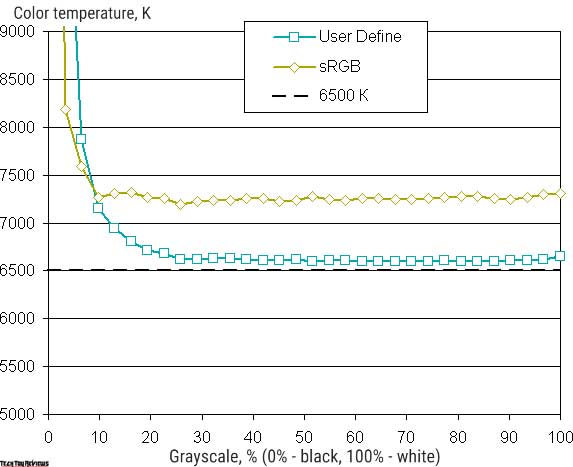
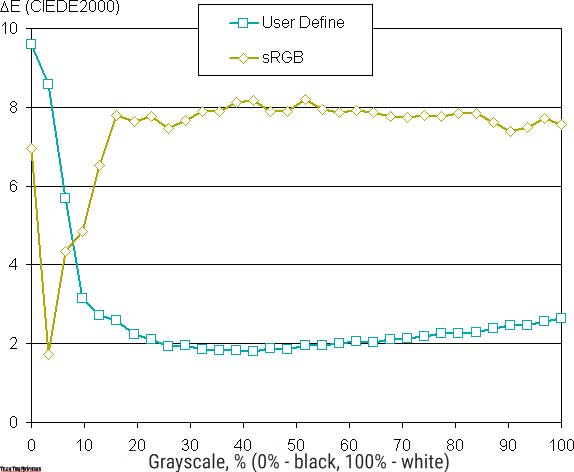
The range closest to black can be ignored, since the color rendering is not so important in it, and the measurement error of color characteristics is high.
Brightness measurements were taken at 25 points on the screen spaced 1/6 of the screen width and height (screen borders not included, monitor settings set to provide maximum brightness and contrast). The contrast was calculated as the ratio of the brightness of the fields at the measured points.

If you step back from the edges, then the white uniformity is very good, and the black, and as a result, the contrast, is much worse. The contrast for this type of matrices is typical by modern standards. It is visually seen that the black field is mostly overexposed closer to the edges. The photo below demonstrates this:

However, the nature and degree of black exposure can greatly depend on the instance.
If you turn on the DCR (Dynamic Contrast) mode, then global (over the entire screen area) brightness adjustment works – on very dark scenes, the backlight brightness decreases, and on a black field in the entire screen, the backlight turns off completely, but the white mouse cursor is enough to turn on the backlight. This adjustment of the backlight brightness can improve the perception of dark scenes. The graph below shows how the brightness (vertical axis) increases when switching from black (after five seconds of output) to white with dynamic brightness off and on:
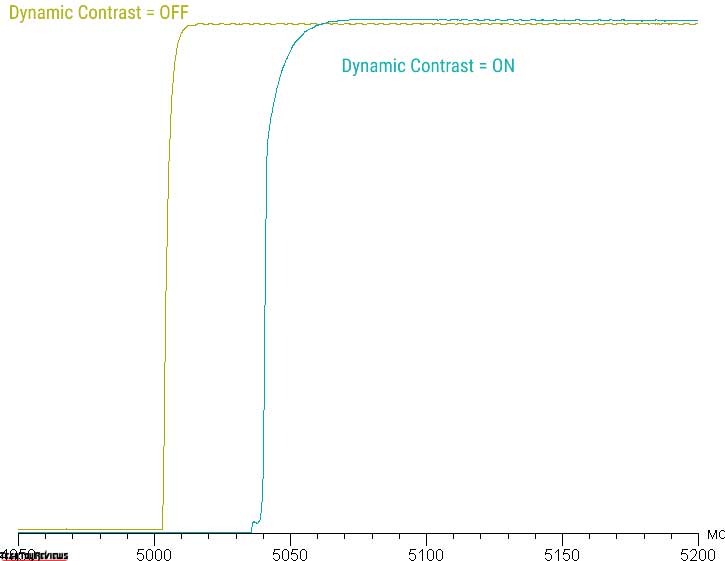
In the case of DCR, there are two tiny delays – at the beginning of the white box output and after the first jump in brightness.
Power consumption
The brightness of the white field in the center of the screen and the power consumption from the network (the rest of the settings are set to values that provide maximum image brightness, nothing is connected to the USB ports, and the refresh rate is 240 Hz):

In standby mode, our Gigabyte M27Q X review unit consumes about 0.25 W, and in the conditionally off state – 0.23 W.
The monitor brightness is changed precisely by the brightness of the backlight, without compromising the quality of the image (the contrast and the number of distinguishable gradations are preserved), the brightness of the monitor can be changed over a wide range, which allows you to comfortably play games, work and watch movies both in bright and in a dark room. At any brightness level, there is no significant backlight modulation, which eliminates visible screen flicker. For those who are used to recognizing the familiar abbreviation, let’s clarify: there is no PWM. As proof, here are graphs of the dependence of brightness (vertical axis) on time (horizontal axis) at various values of the brightness setting:
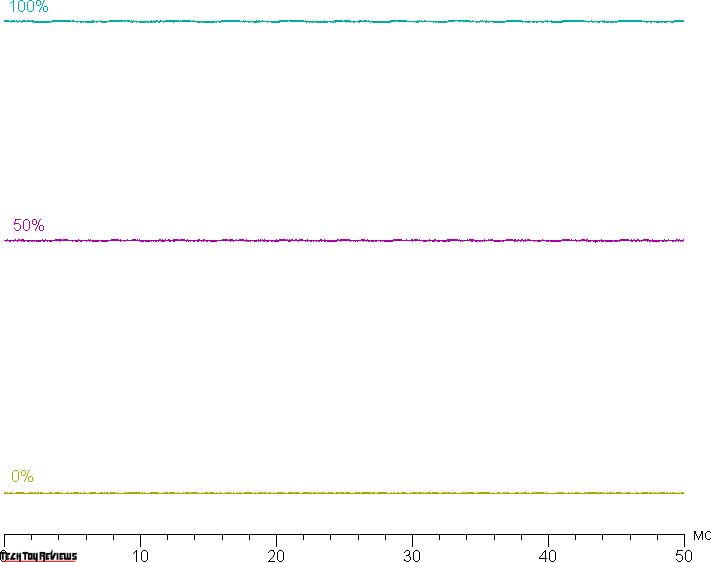
There is a mode with an insertion of a dark frame (in this case it is not black) called Aim Stabilizer Sync. Brightness (vertical axis) versus time (horizontal axis) when brightness is set to maximum (left half) and when Aim Stabilizer Sync is enabled (right half):
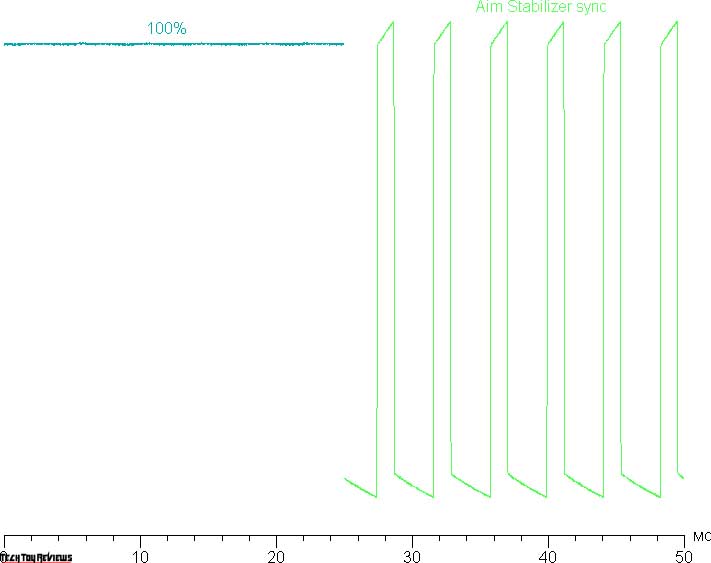
The clarity in motion does improve, but due to flickering up to a maximum of 240Hz that can be detected in some cases. This mode is recommended to be used with caution, as flickering can lead to increased eye fatigue. In addition, when this mode is turned on, the brightness is greatly reduced (from 445 to 172 cd/m²), which also reduces its value.
Heating
The heating of the our Gigabyte M27Q X review unit can be estimated from the following image from the IR camera, obtained after the monitor was used for a long time at maximum brightness (HDR mode) in a room with a temperature of approximately 24° C:

Apparently, at the bottom is the LED line of the screen backlight.

The rear heat is moderate. The PSU case has heated up to 48° C, which is quite a lot:

Response time and delay
The response time depends on the value of the Overdrive setting, which controls the overclocking of the matrix. There are five adjustment levels. The graph below shows how the on and off times change during the black-white-black transition (on and off bars), as well as the average total time for transitions between grayscales (GTG bars) in the case of a mode with a refresh rate of 240 Hz:
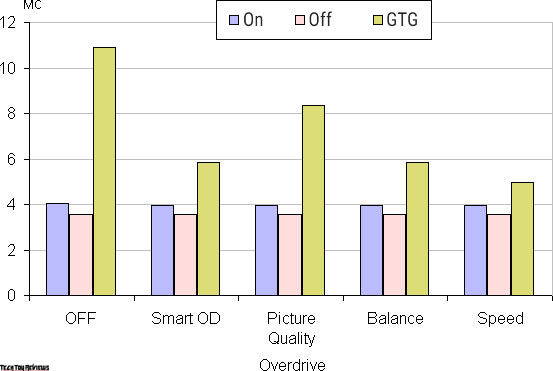
Below are graphs of the halftone transition between shades of 50% and 70% and back at different Overdrive settings (vertically – brightness, horizontally – time, for clarity, the graphs are arranged sequentially):
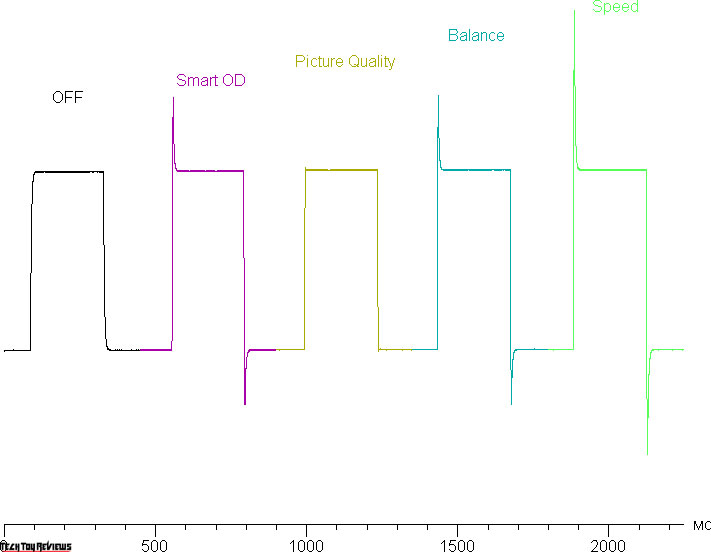
You can stop at the Balance option since at the maximum overclocking the artifacts are already quite noticeable (in fact, in some dynamic pictures, artifacts are visible even in the case of minimal overclocking). From our point of view, even after moderate overclocking, the matrix speed is enough for dynamic games.
Here is the dependence of brightness on time when alternating white and black frames at a 240 Hz frame rate. The brightness of the white box is 100% on the graph:
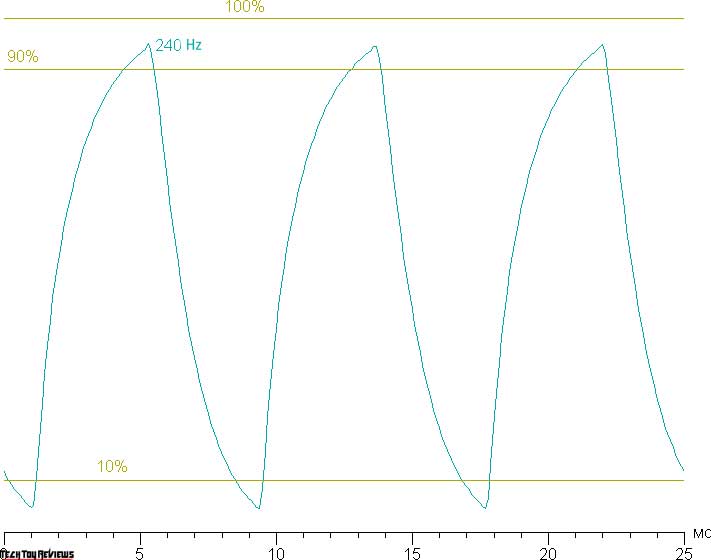
It can be seen that at 240 Hz interlacing, the maximum brightness of the white frame is above the 90% white level, and the minimum brightness of the black frame is below 10%. The amplitude of the change in brightness is greater than 80% of the white level. According to this formal criterion, the matrix speed is sufficient to display an image with a frame rate of 240 Hz.
For a visual representation of what such a matrix speed means in practice, what overclocking artifacts can be, and whether the Aim Stabilizer Sync setting described above improves clarity in motion, we present a series of shots taken with a moving camera. Such pictures show what a person sees if he follows with his eyes an object moving on the screen. Recommended settings were used (motion speed 960 ppi/s for refresh rates 60, 120, and 240 Hz), shutter speed 1/15s, refresh rates are shown in the photos, as well as the overclock stage (OD=x) and whether Aim Stabilizer Sync is enabled.

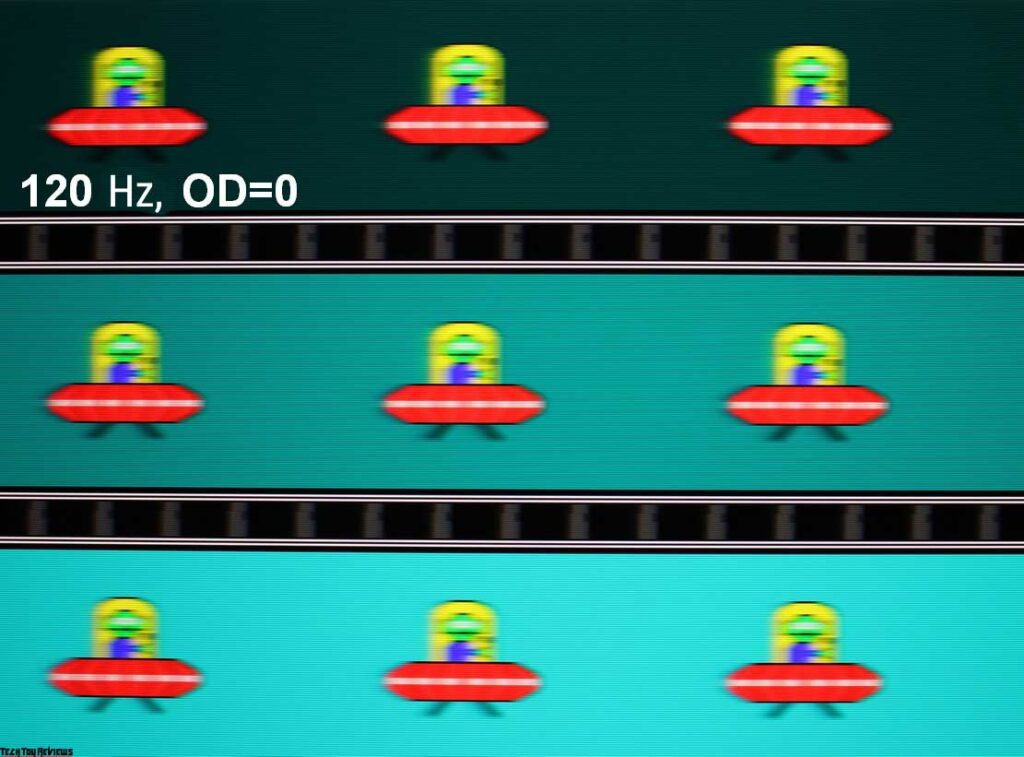
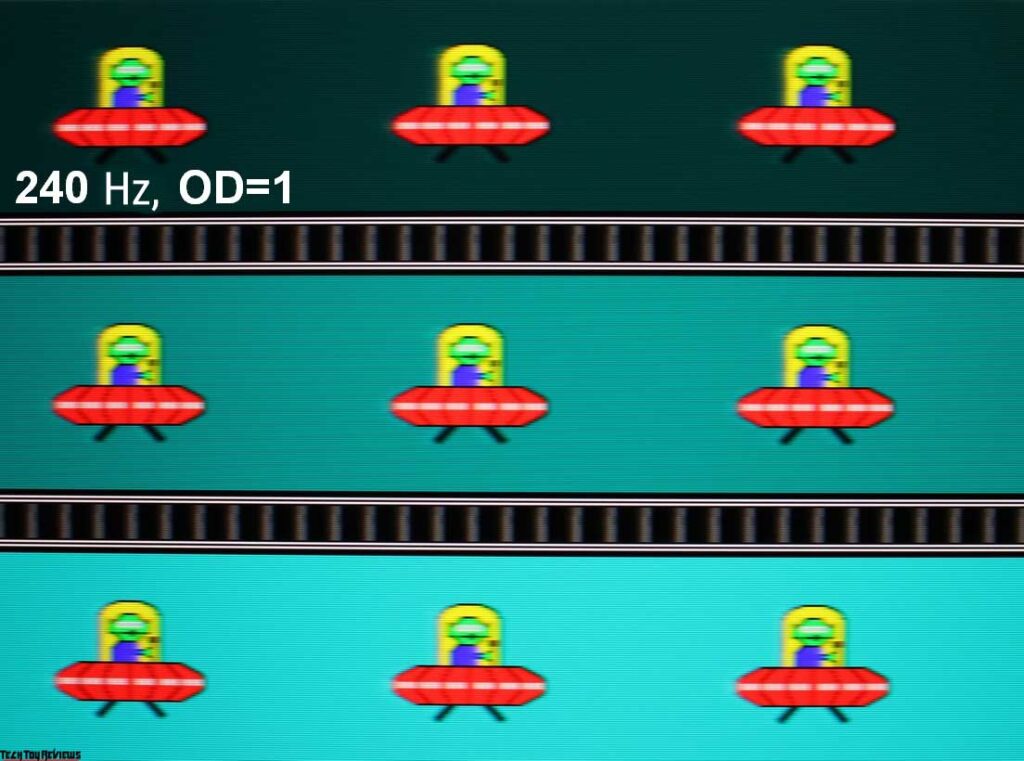

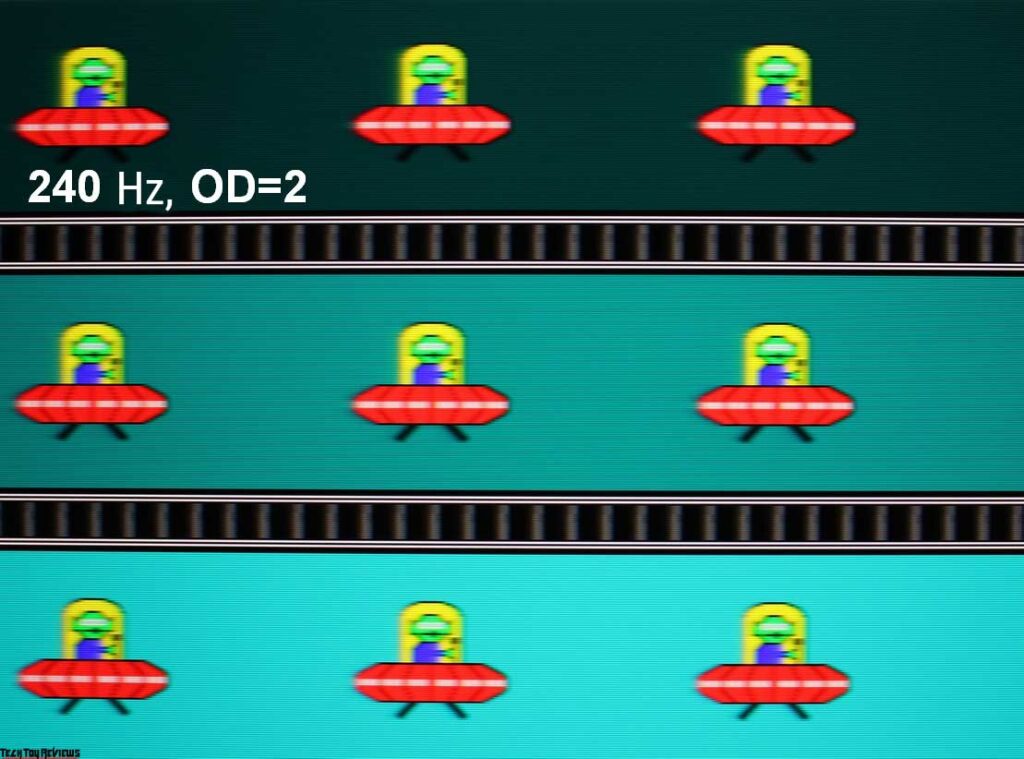
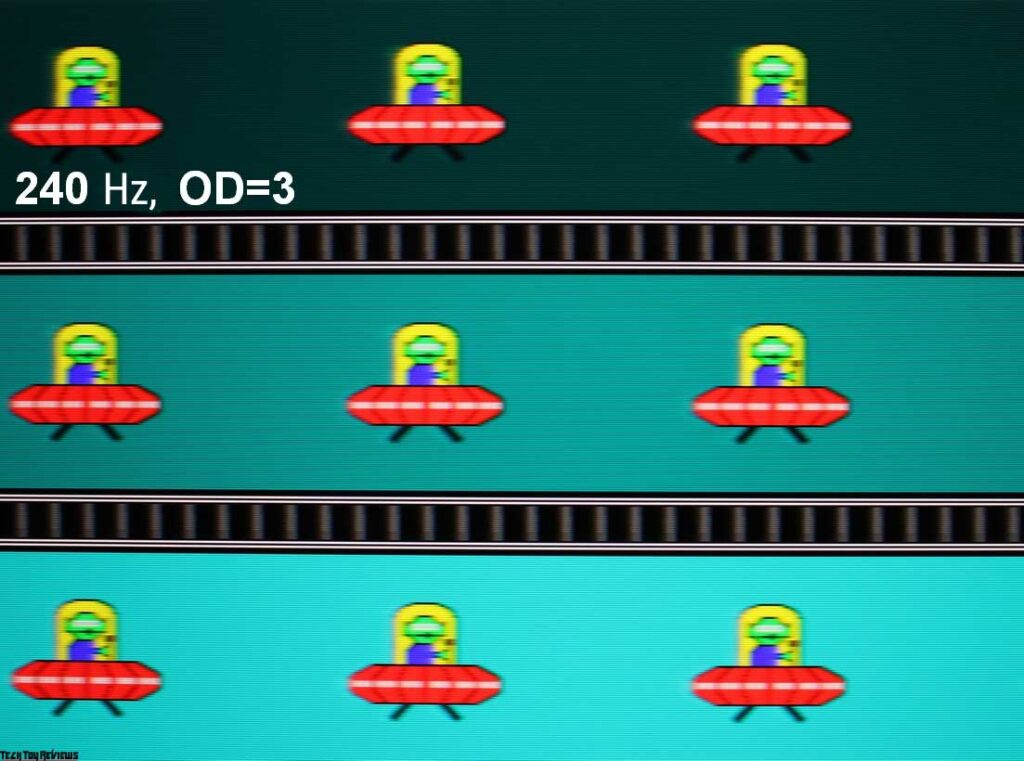
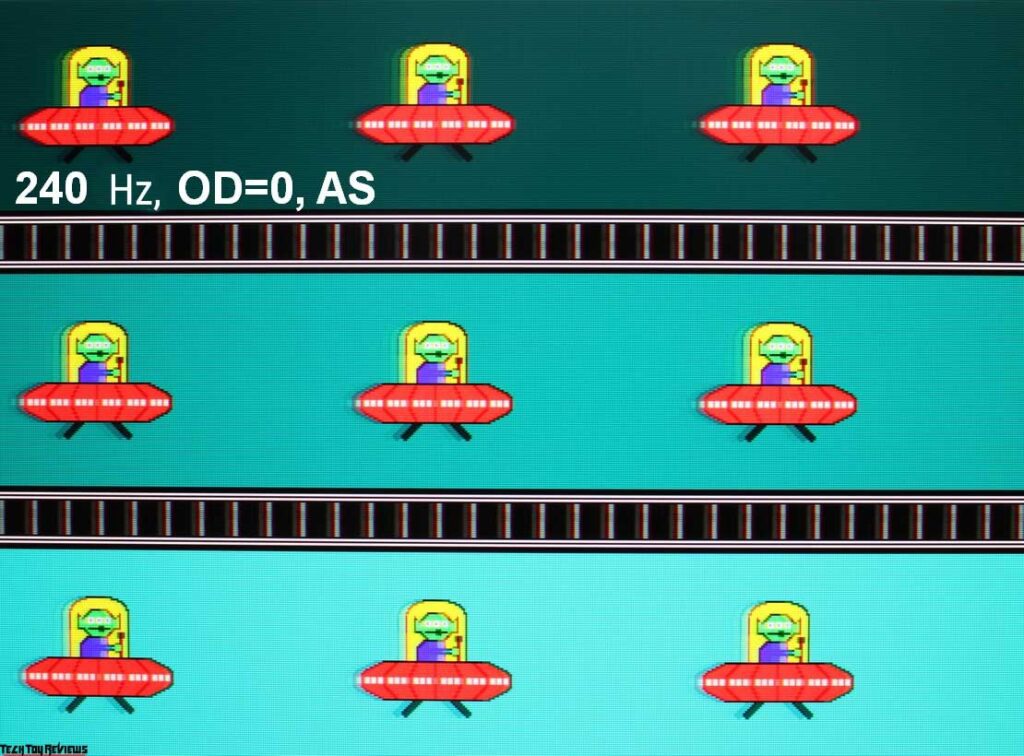

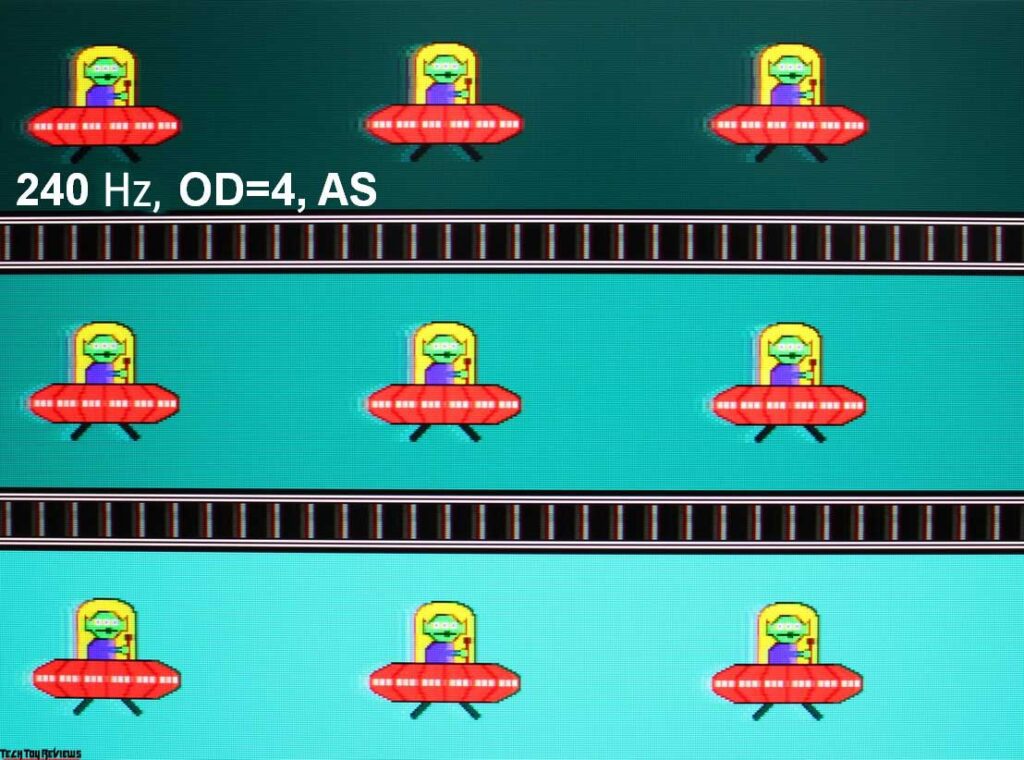
It can be seen that other things being equal, the image clarity increases as the refresh rate and overclocking increase, but at maximum overclocking, the artifacts are already very noticeable. Enabling Aim Stabilizer Sync increases sharpness up to one pixel horizontally, but objects in motion triple, which reduces the positive effect. In this mode, you can do without overclocking the matrix.
Let’s try to imagine what would happen in the case of a matrix with instant pixel switching. For it, at 60 Hz, an object with a motion speed of 960 pixels/s is blurred by 16 pixels, at 120 Hz – by 8, and at 240 Hz – by 4 pixels. Blurred as the focus moves at the specified speed and the subject remains stationary for 1/60, 1/120, or 1/240 second. To illustrate this, let’s simulate a blur by the appropriate number of pixels:




It can be seen that the clarity of the image after moderate overclocking of the matrix is almost the same as that of an ideal matrix.
We determined the total output delay from switching pages of the video buffer to the start of displaying the image on the screen (recall that it depends on the features of the Windows OS and the graphics card, and not only on the monitor). Image output latency at 240Hz is only 2.6ms. It is a very low delay, it will not feel when working on a PC, and in games, it will not lead to a decrease in performance.
Viewing angles
To find out how the brightness of the screen changes as the screen deviates from vertical, we took a series of measurements of the brightness of the colors black, white, and gray at the center of the screen at a wide range of angles, with the axis divergence of the sensor in vertical, horizontal and diagonal (corner to corner format for 16:9).
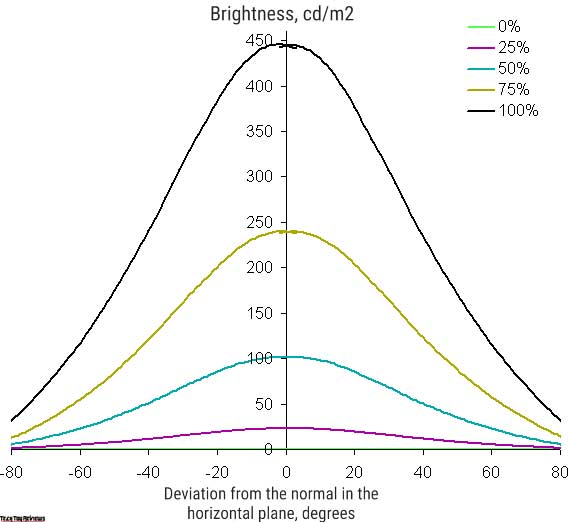
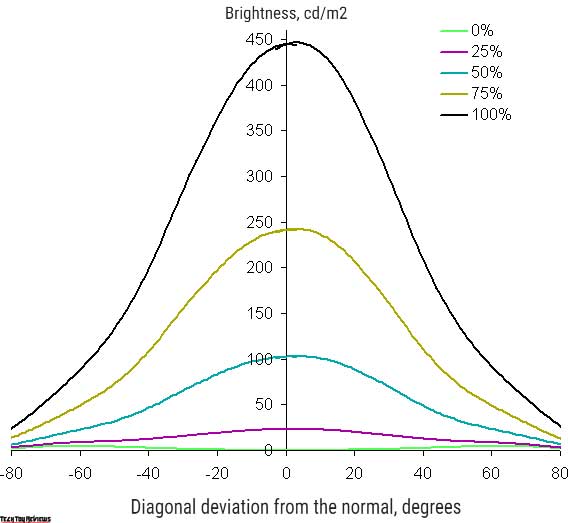
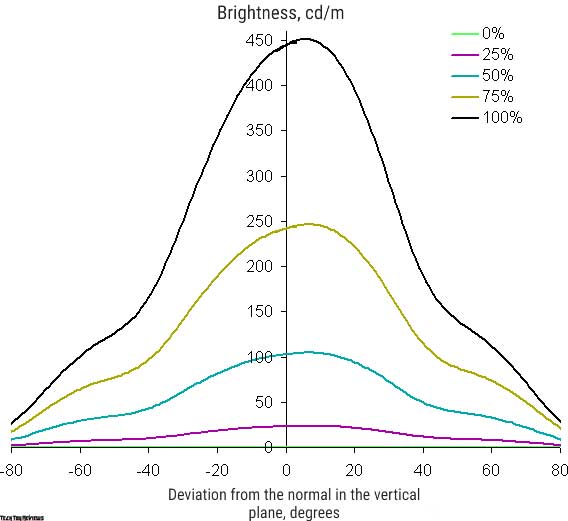
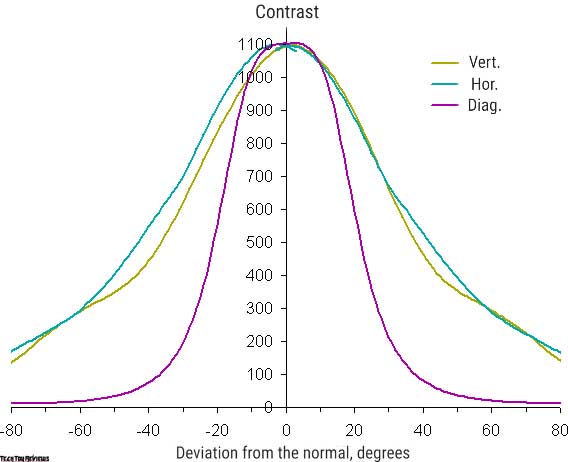
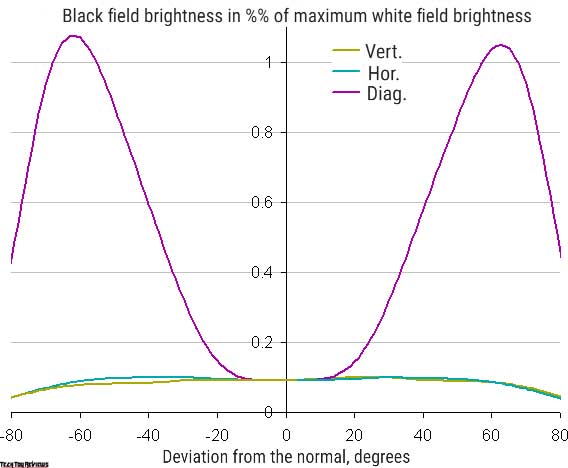
Decreasing brightness by 50% of the maximum value:

Viewing angles are wide enough to reduce the brightness. With deviations in the diagonal direction, the brightness of the black area begins to increase sharply at 20 ° -30 ° deviations from the vertical on the screen. If you sit not very far from the screen, the dark areas in the corners will be much lighter than in the center. In the case of diagonal deviation, the contrast reaches 10:1 in the range of angles of ±82° but still does not drop below.
Final line
The Gigabyte M27Q X is a high-end gaming monitor. Its features include a large QHD resolution screen and a modest gaming look. There is support for a refresh rate of 240 Hz, AMD FreeSync Premium, and Nvidia G-Sync compatibility. Traditionally for Gigabyte gaming monitors, there are a set of gaming features, some of which work in conjunction with specialized software.
The monitor is great for any number of games and, for example, watching movies and working with lots of information. It can also be used for work that requires high colorfastness in the field and when viewed from an angle, for example, for processing graphic images and editing video content. Note that the monitor is not suitable as a full-fledged docking station for a laptop due to the low output power of the USB-C port. What is your opinion about this Gigabyte M27Q X review? Do let us know in the comment below.
Gigabyte M27Q X price and availability
Gigabyte M27Q X gaming monitor is available to buy from Amazon.com, Bhphotovideo.com, and Amazon.co.uk websites for $469.99 / £361.32.
 Technology News, Reviews and Buying Guides review, monitor review, tablet review, laptop review, mobile review, smartphone review, buying guide,
Technology News, Reviews and Buying Guides review, monitor review, tablet review, laptop review, mobile review, smartphone review, buying guide,
